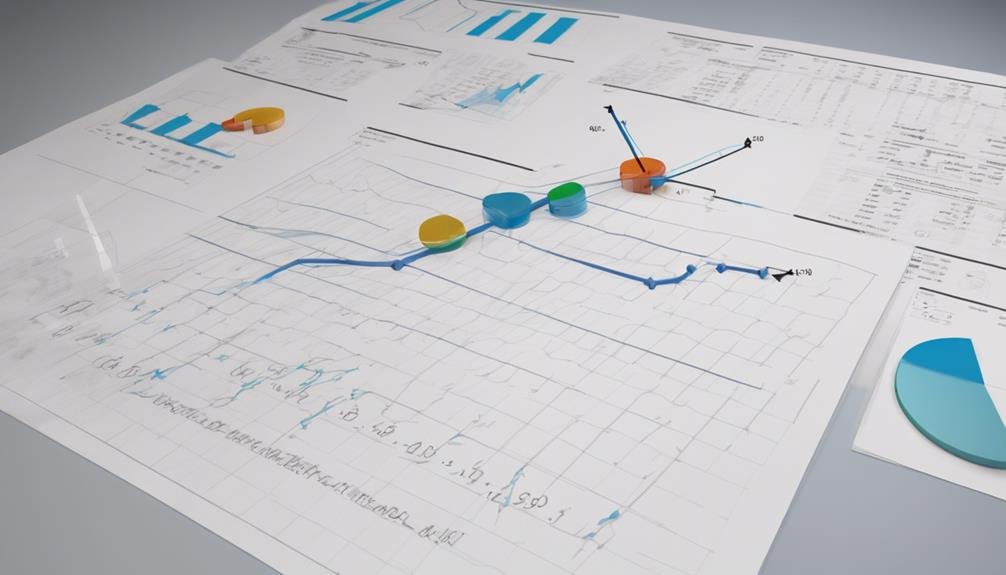Break-Even Analysis: Formula and Calculation
Break-even analysis is vital for evaluating costs, revenues, and profits. The formula for calculating the break-even point is BEP = Fixed Costs / (Price Per Unit – Variable Cost Per Unit). This calculation determines when total revenues equal total costs. It provides insights into financial health, profitability, and aids in decision-making regarding pricing strategies and cost control measures. Delving further into contribution margin analysis can help evaluate product profitability and guide strategic decisions. Understanding break-even analysis is essential for businesses aiming to optimize financial planning and strategic decision-making processes.
Key Takeaways
- Break-even analysis formula: BEP = Fixed Costs / (Price Per Unit – Variable Cost Per Unit)
- Determines when total revenues equal total costs for financial viability assessment.
- Contribution margin: Selling price minus variable cost per unit for profitability evaluation.
- Essential for decision-making on pricing strategies and cost control measures.
- Sensitivity analysis and cost volume profit analysis provide valuable insights for financial health assessment.
Break-Even Analysis Essentials
The Break-Even Analysis essentials serve as a fundamental framework for businesses to evaluate the relationship between costs, revenue, and profit. Understanding the cost structure is vital in determining the breakeven point and profitability evaluation. By analyzing fixed costs, such as rent and insurance, alongside variable costs like raw materials, businesses can pinpoint the level of sales needed to cover all expenses.
This analysis aids in evaluating the financial health of a company and its ability to generate profit. Additionally, it provides insights into the cost structure of the business, highlighting areas where cost reductions may be possible to enhance profitability. Overall, Break-Even Analysis essentials are crucial tools for businesses aiming to make informed decisions based on a thorough understanding of their financial dynamics.
Break-Even Point Calculation Steps
Building upon the foundational understanding of Break-Even Analysis essentials, the process of calculating the Break-Even Point involves specific steps that are vital for evaluating a business's financial viability and profitability.
This calculation is essential for businesses to determine the point at which their total revenues equal total costs, resulting in neither profit nor loss. The Break-Even Point can be computed using the formula BEP = Fixed Costs / (Price Per Unit – Variable Cost Per Unit).
Additionally, conducting sensitivity analysis and cost volume profit analysis can provide valuable insights into how changes in factors such as sales volume or costs impact the Break-Even Point. These analytical tools help businesses make informed decisions regarding pricing strategies, cost control measures, and overall financial performance.
Break-Even Point and Contribution Margin
Utilizing the concept of contribution margin analysis provides businesses with a strategic tool to evaluate the profitability of their products. By determining a product's contribution margin, which is the selling price minus the variable cost per unit, companies can calculate the break-even point in terms of units or sales dollars.
This calculation enables firms to understand the level of sales needed to cover all fixed costs and begin generating profit. The contribution margin analysis also offers decision-making insights, guiding businesses in setting pricing strategies and evaluating the impact of cost structures on profitability.
Through this analysis, organizations can make informed decisions regarding new product introductions, cost reductions, and overall performance metrics to enhance financial outcomes.
Practical Applications of Break-Even Analysis
Practical application of break-even analysis lies in its ability to provide businesses with a clear financial roadmap for decision-making. Market segmentation plays an essential role in this application, allowing businesses to target specific customer segments with tailored pricing strategies based on break-even calculations. By understanding the break-even point for each segment, companies can optimize their pricing to maximize profits and market share.
Additionally, break-even analysis aids in evaluating production efficiency by identifying the level of output required to cover costs and generate profits. This analysis helps businesses streamline production processes, minimize waste, and improve overall operational efficiency. By incorporating market segmentation and focusing on production efficiency, break-even analysis becomes a powerful tool for strategic decision-making and sustainable growth.
Addressing Limitations in Break-Even Analysis
To enhance the accuracy and reliability of break-even analysis, it is essential to address the inherent limitations and consider external factors that can impact the analysis outcomes.
- External factors play an important role in break-even analysis, particularly in dynamic environments.
- Changes in technology can greatly alter cost structures and break-even points.
- Market conditions such as demand fluctuations can affect sales volumes and pricing strategies.
- Inflation can impact both costs and revenues, influencing the break-even point.
- Non-linear cost-production relationships can introduce complexities that traditional break-even analysis may not capture accurately.
Conclusion
To sum up, break-even analysis serves as an essential tool for businesses to assess profitability and make informed decisions. By calculating the break-even point and considering contribution margin, organizations can better understand cost structures and product profitability.
Despite its limitations, break-even analysis remains a key component in strategic planning and budgetary considerations, offering valuable insights into the financial health of a company. The meticulous analysis of financial metrics enables businesses to optimize operational efficiency and drive sustainable growth.







